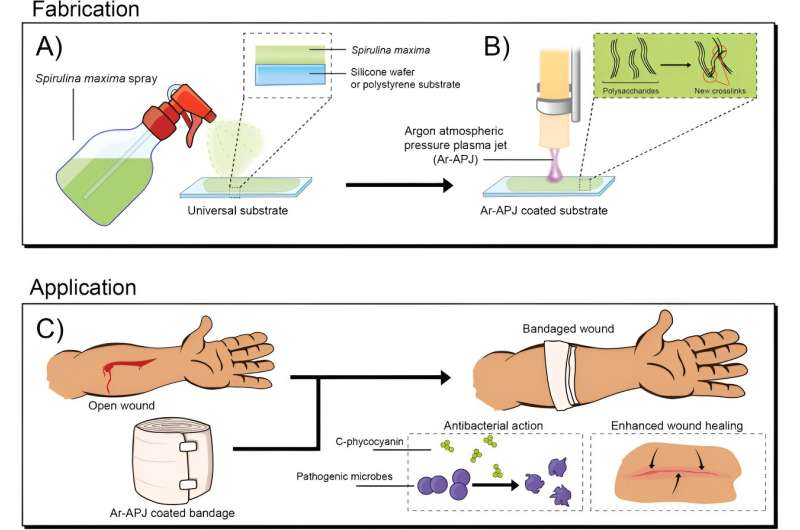Plasma technology transforms microalgae coating for wounds
Originally published by Flinders University, on October 10, 2023
A schematic depicting the one-step argon atmospheric pressure plasma jet (Ar-APJ) process to transform S. maxima biomass into an ultrathin bioactive coating. A) S. maxima is sprayed onto a universal substrate. B) Ar-APJ process transforms the S. maxima biomass into a durable, bioactive, ultrathin coating. C) Antibacterial wound dressings as a proposed application for the Ar-APJ technology. Credit: Small (2023). DOI: 10.1002/smll.202305469
Researchers at Flinders University have taken a significant leap in the field
of wound care using an innovative approach. By deploying an argon atmospheric
plasma jet, they have successfully transformed Spirulina maxima, a blue-green
microalgae, into ultrathin bioactive coatings.
These coatings not only tackle bacterial infections but also promote faster wound healing and possess potent anti-inflammatory properties. This holds promise especially for the treatment of chronic wounds, which often pose challenges due to prolonged healing times.
The novel approach could reduce the risk of toxic reactions to silver and other nanoparticles and rising antibiotic-resistance to common commercial coatings used in wound dressing.
The latest development, published in the nanotechology journal Small, reveals a new, just-patented plasma-assisted technology that sustainably processes a Spirulina maxima biomass into bioactive ultrathin coatings that can be applied to wound dressings and other medical devices and are capable of uniquely protect patients from infection, accelerate healing and modulate inflammation.
The new technique could be readily applied to other types of natural supplements, says Dr. Vi Khanh Truong, from the Flinders University Biomedical Nano-engineering Laboratory.
"We are using the plasma coating technology to turn any type of biomass—in this case Spirulina maxima—into a sustainable high-end coating.


Comments
Post a Comment